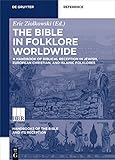The Bible in Folklore Worldwide. Volume I, A Handbook of Biblical Reception in Jewish, European Christian, and Islamic Folklores / ed. by Eric Ziolkowski.
Material type: TextSeries: Handbooks of the Bible and Its Reception (HBR) ; 1/1Publisher: Berlin ; Boston : De Gruyter, [2017]Copyright date: ©2017Description: 1 online resource (XVI, 378 p.)Content type:
TextSeries: Handbooks of the Bible and Its Reception (HBR) ; 1/1Publisher: Berlin ; Boston : De Gruyter, [2017]Copyright date: ©2017Description: 1 online resource (XVI, 378 p.)Content type: - 9783110286717
- 9783110388688
- 9783110286724
- 398
- GR
- online - DeGruyter
- Issued also in print.
| Item type | Current library | Call number | URL | Status | Notes | Barcode | |
|---|---|---|---|---|---|---|---|
 eBook
eBook
|
Biblioteca "Angelicum" Pont. Univ. S.Tommaso d'Aquino Nuvola online | online - DeGruyter (Browse shelf(Opens below)) | Online access | Not for loan (Accesso limitato) | Accesso per gli utenti autorizzati / Access for authorized users | (dgr)9783110286724 |
Frontmatter -- Contents -- Acknowledgments -- Style and Transliteration -- Illustrations -- Abbreviations -- Introduction -- 1. Jewish (Mizrahi) -- 2. Jewish (Sephardi) -- 3. Jewish (Ashkenazi Influences) -- 4. Romance (French and Romanian) -- 5. German -- 6. Nordic/Scandinavian -- 7. British and Irish -- 8. East Slavic -- 9. West Slavic -- 10. South Slavic -- 11. Islamic -- Contributors -- Scriptural Index -- Folkloric Index -- General Index
restricted access online access with authorization star
http://purl.org/coar/access_right/c_16ec
This first volume of a two-volume Handbook treats a challenging, largely neglected subject at the crossroads of several academic fields: biblical studies, reception history of the Bible, and folklore studies or folkloristics. The Handbook examines the reception of the Bible in verbal folklores of different cultures around the globe. This first volume, complete with a general Introduction, focuses on biblically-derived characters, tales, motifs, and other elements in Jewish (Mizrahi, Sephardi, Ashkenazi), Romance (French, Romanian), German, Nordic/Scandinavian, British, Irish, Slavic (East, West, South), and Islamic folkloric traditions. The volume contributes to the understanding of the Hebrew Bible/Old Testament, the New Testament, and various pseudepigraphic and apocryphal scriptures, and to their interpretation and elaboration by folk commentators of different faiths. The book also illuminates the development, artistry, and “migration” of folktales; opens new areas for investigation in the reception history of the Bible; and offers insights into the popular dimensions of Jewish, Christian, and Muslim communities around the globe, especially regarding how the holy scriptures have informed those communities’ popular imaginations.
Issued also in print.
Mode of access: Internet via World Wide Web.
In English.
Description based on online resource; title from PDF title page (publisher's Web site, viewed 28. Feb 2023)


